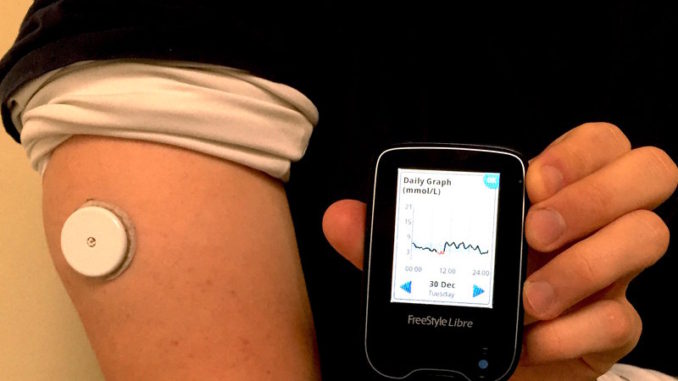
No More Finger Sticks: FDA Approved Abbott’s FreeStyle Libre Flash Glucose Monitoring System
First Continuous glucose monitoring system for adults not requiring blood sample calibration
First Continuous glucose monitoring system for adults not requiring blood sample calibration
The U.S. FDA has approved Abbott’s FreeStyle Libre Flash Glucose Monitoring System as a replacement for blood glucose monitoring (BGM) for adults with diabetes. This revolutionary new glucose sensing technology eliminates the need for routine finger sticks and is the only personal continuous glucose monitor (CGM) that does not require finger stick calibration. Designed to be approachable, accessible and affordable for the 30 million people with diabetes in America, the FreeStyle Libre system reads glucose levels through a sensor that is worn on the back of the upper arm for up to 10 days, making it the longest lasting personal glucose sensor available in the U.S.
The BGM replacement indication means that people with diabetes and their physicians can now make treatment decisions based on information from the FreeStyle Libre system, without the need for finger sticks. The cost of the Libre Flash Glucose Monitoring System is just a fraction of the cost of other CGM systems currently available.
“Today, we are celebrating a breakthrough moment for people with diabetes in the U.S.–an end to the worry and hassles associated with routine finger sticks which have been the standard of glucose testing for more than 40 years,” said Jared Watkin, senior vice president, Diabetes Care, Abbott. “At Abbott, we believe that FreeStyle Libre will transform diabetes management and we’re proud to be at the forefront of innovation that empowers people to take control of their health to live their best lives.”

How The Freestyle Libre System WorksWith the FreeStyle Libre system, people with diabetes can:
|
With traditional BGM, some people with diabetes may have to finger stick up to 12 times per day, to test their glucose levels, which only provides readings that represent distinct points in time. Studies have shown that a majority of people test less than three times per day because of the pain and hassles associated with finger sticks. Without comprehensive glucose data, significant glucose fluctuations may be missed, which can lead to major health consequences.
Even with current CGM devices, people still have to finger stick at least twice per day, based on their system, to calibrate their devices to ensure accuracy. However, the FreeStyle Libre system is factory calibrated so daily calibration is not required–another first in the personal glucose monitoring industry.
Visualizing Data To Better Identify Trends And Patterns
The data from the FreeStyle Libre system provides a visual snapshot of a person’s glucose fluctuations during a typical day, called an Ambulatory Glucose Profile (AGP). The AGP can reveal hypoglycemic (low blood sugar) and hyperglycemic (high blood sugar) trends intended to help facilitate better diabetes management. By measuring, capturing and storing glucose level data continuously, patients and their doctors can see patterns over time and make adjustments to lifestyle, diet or treatment.
The importance of the AGP has been recognized by the American Association of Clinical Endocrinologists, which recently recommended that the health care industry standardize this report across all glucose monitoring devices so more physicians and patients will have access to this tool.
Studies Show People Test More And Spend Less Time In Hypoglycemia With The Freestyle Libre System
Two published clinical trials and real-world evidence from more than 50,000 FreeStyle Libre users show that people who use the FreeStyle Libre system test their glucose levels an average of at least 15 times per day. The studies show that people who scan more frequently spend less time in hypoglycemia or hyperglycemia while having improved average glucose levels, demonstrating improved glucose control overall.
“Diabetes management requires active participation by the patient. Regular monitoring of glucose levels is especially crucial among patients being treated with insulin,” said Maria Tulpan, M.D., Lenox Hill Hospital, New York, N.Y. “What we see with the FreeStyle Libre system is patients gaining a better understanding of the impact of food, exercise and specific medications on their glucose levels due to availability of the data, which is important in the day-to-day management of diabetes and for behavioral changes towards improved diabetes control.”
Where Can You Find The Freestyle Libre System
In the U.S., the FreeStyle Libre system will be available via prescription before the end of the year at major retail pharmacies. The FreeStyle Libre system is now being used by more than 400,000 people across approximately 40 countries18. To ensure accessibility to the FreeStyle Libre system, Abbott has secured partial or full reimbursement in 17 countries, including France, Japan and the United Kingdom.
For more information, please visit: www.freestylelibre.us.







Leave a Reply